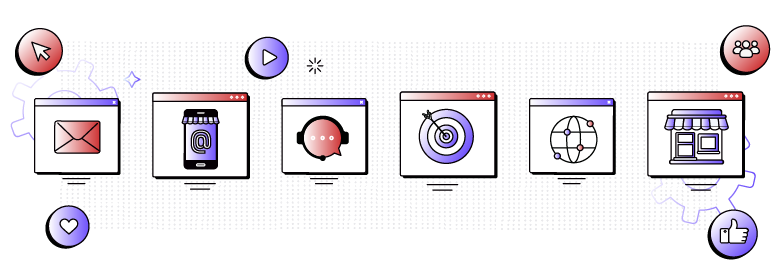With the abundance of choices available to consumers and a growing expectation for convenience, tailoring shopping experiences is paramount for engaging customers, driving sales, and building long-lasting relationships. With such demand, technology has made it possible to optimise each customer touchpoint to every preference and need. Retailers can implicitly and explicitly react to custom signals, sometimes even before the customer has arrived on a site.
But whilst personalisation has never been so important, according to Netcore, only 41% of retail executives think their e-commerce platform is somewhat personalised, and just 13% claim it provides a totally tailored experience.
It seems even the most well-intentioned businesses are stumbling upon common commerce personalisation errors that hinder their success.
To unleash the full potential of your e-commerce site and cultivate lasting customer relationships, we’re shedding light on the key commerce personalisation mistakes some of the biggest brands are still making to help you navigate the path to e-commerce excellence.
1. Neglecting to gather and utilise data effectively
Time and time again we encounter brands who not only struggle to collect good data but fail to utilise the information they have to optimise their e-commerce site for the best results. From purchase history to browsing behaviour, every piece of data holds valuable insights that can power personalised experiences and encourage better engagement on your site.

To avoid this mistake, ensure you have a robust data collection system. Invest in tools that can track customer interactions and integrate data from various sources. Additionally, use analytics platforms to gain actionable insights and develop targeted strategies that resonate with your customers. We recommend starting with a tool such as GA4 which can give you basic to complex reports on your site. As your e-commerce ecosystem expands into omnichannel experiences, you may want to consider a more advanced platform to understand a broader range of data sources so you can provide the most tailored and personalised shopping experiences.
2. Overlooking segmentation and targeting
As your brand expands, your content needs to reflect an increasing number of different audiences, all of whom require bespoke messaging depending on their demographics, where they are in their buying journey and their purchasing behaviour. Retailers who fail to effectively segment their audiences can risk appearing too generic with experiences that disengage their customers.
 To avoid falling behind competitors, divide your audience into meaningful segments based on preferences and behaviour to create clear buyer personas to whom you can tailor your online experiences. Our Conversation Rate Optimisation Roadmapping can help you to understand your customer demographics and give you a clear action plan to create engaging customer journeys that reduce site or basket abandonment. Book a short discovery call to see how we can help.
To avoid falling behind competitors, divide your audience into meaningful segments based on preferences and behaviour to create clear buyer personas to whom you can tailor your online experiences. Our Conversation Rate Optimisation Roadmapping can help you to understand your customer demographics and give you a clear action plan to create engaging customer journeys that reduce site or basket abandonment. Book a short discovery call to see how we can help.
3. Overwhelming customers with choices
In a study conducted by Sheena Iyengar and Mark Lepper from Columbia and Stanford University, they found that when displaying just 6 jams rather than 24 led to an increase in sales, proving that too many choices meant people were far less likely to buy.

The same applies when e-commerce stores fail to offer streamlined and specific product recommendations and suggestions and instead show everything they have to every visitor. Basic e-commerce platforms use simple algorithms to offer generic suggestions which don’t align with a customer’s preferences and cause confusion and create frustration.
Brands need to strike a balance between offering extra choices to encourage increased AOV whilst also ensuring recommendations are personalised to avoid overwhelming customers.
Investing in advanced product recommendations and an onsite search engine which utilises machine learning and AI techniques will help create more specific recommendations for your customers. These engines can analyse vast amounts of customer data, identify patterns, and generate highly accurate, personalised offers. By using purchase history, browsing behaviour, and related products shoppers are given relevant and enticing suggestions that enhance their buying experience.
4. Ignoring omnichannel personalisation
For most B2C retailers, and increasing numbers of B2B brands, customers are shopping across a large array of digital, physical and now virtual touchpoints before they make a purchase. Think social commerce, voice-activated devices, and AR to name a few.
One of the biggest mistakes we see retailers making is that whilst their personalisation may be the gold standard on their digital store, this is not consistent across their entire digital ecosystem. In this instance, customers are frustrated by incohesive experiences as they switch between multiple channels.

Focus on integrating your personalisation efforts across all channels so customers are able to pick up where they left off, regardless of the platform or device they are using.
We know this may seem like a daunting task, you’re likely to have many touchpoints already set up which require personalisation. Consider how your customers are interacting with your brand throughout their journey, which channels they are using, and how to create the most cohesive experience at each of these. You may need to reassess your current technology stack if personalisation options are limited, or if you don’t have a personalisation tool in place. This is where a composable commerce model can be the best fit for retailers. The goal is to create the most bespoke, seamless experience for every customer to drive engagement and increase sales.
5. Lack of testing and iteration
Lack of sufficient testing to understand how things are working, and where they can be improved is often the biggest oversight retailers make with e-commerce personalisation. This is usually down to limited time, resources or knowledge about how to carry out effective testing and optimisation. The problem is, personalisation by nature needs to be tailored to specific segments, products and business models in order to work most effectively. Combine sporadic testing within a lightning-fast market and your personalisation efforts become outdated and irrelevant very quickly.
Implement a rigorous testing framework to evaluate the impact of personalisation efforts. Conduct A/B tests on different messaging, recommendation strategies, and user interfaces. Analyse the results, identify what works best for each customer segment, and refine your personalisation tactics accordingly. Moving forward, your teams need only to monitor and adapt their approach to ensure your brand is offering the most personalised experience for your customers.
Final thoughts
It’s been some time since personalisation was merely nice-to-have. Brands must tailor their digital experiences to put increasingly distracted customers at the centre of every touchpoint to truly connect and engage with them.
By avoiding these common commerce personalisation mistakes and implementing effective strategies, e-commerce businesses can create bespoke experiences that drive sales, and foster long-term customer loyalty.
Embracing personalisation as a core component of the e-commerce journey will undoubtedly give businesses a competitive edge in the ever-evolving digital landscape.
Talk to our team about how you can maximise your sales and site engagement with industry-leading personalisation strategies. Book a call here.

